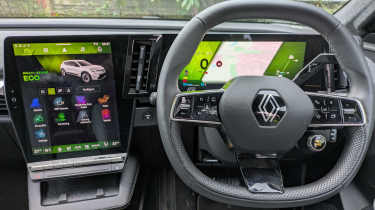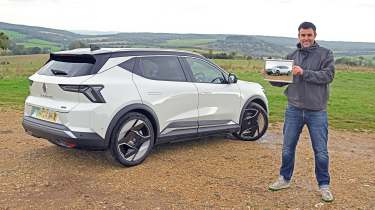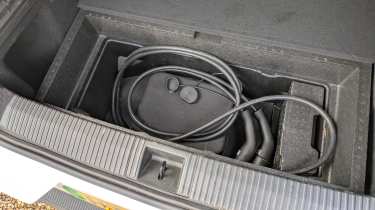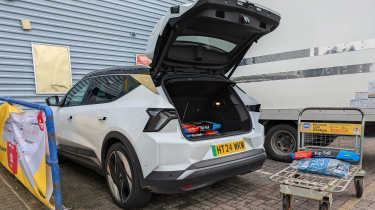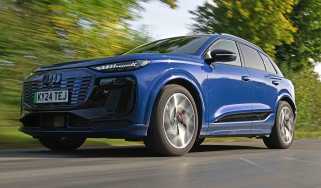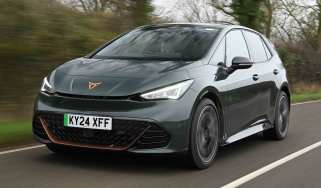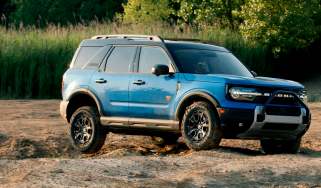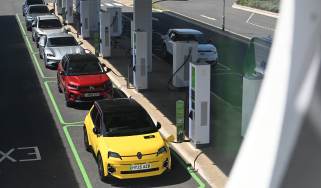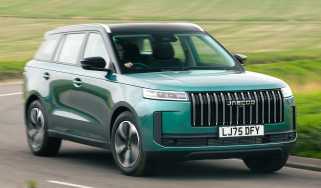Renault Scenic Iconic Long Range long-term test: sensible SUV beats back the competition
Final report: we say au revoir to one of our favourite family EVs
Verdict
The Renault Scenic definitely leaves us with a higher opinion of it than we had on its arrival. It’s a really well rounded family car with a lot more style about it than most. It’s probably best described as modern and functional; yes, there are alternatives that feel more luxurious and cosseting for occupants, but very few will prove more agreeable to live with overall.
- Mileage: 6,205
- Efficiency: 3.6 miles/kWh
I consider myself something of an expert in the field of mid-sized electric family cars. I’ve got two kids, an off-road parking space with a home charger and I do a lot of short-trip urban driving, so when cars in this niche arrive on our long-term test fleet, they often get punted in my direction.
Over recent years, I’ve spent months living with the Renault Megane, Skoda Enyaq and Nissan Ariya, while also enjoying stints in the Ford Explorer, Audi Q4 e-tron, Hyundai Ioniq 5 and a few others. The Renault Scenic beats them all.
Sadly, the Renault has now left the fleet, but here we have the chance to look back at what made it a star. It’s worth saying that the mid-sized electric SUV sector is so crowded with talented options that buyers have a battle to differentiate one car from another. But the Scenic stands out, with its sharp lines and modern detailing, themes carried through to an interior that feels light, open and airy, helped by the Solarbay panoramic roof.
Used - available now

2017 Toyota
Auris
45,000 milesManualPetrol1.2L
Cash £8,495
2017 Land Rover
Range Rover Sport
62,500 milesAutomaticDiesel3.0L
Cash £20,990
2014 BMW
1 Series
77,512 milesManualDiesel2.0L
Cash £5,990
2024 Audi
A3 Sportback
27,880 milesAutomaticPetrol1.4L
Cash £19,399The cabin isn’t the most luxurious, but the light fabrics on our top-spec Iconic model give it a modern feel and while the open storage areas in the centre console and wide door pockets can make things look a bit cluttered when they’re full, you’re rarely short of somewhere to put stuff in the Scenic.
Those lighter materials do show marks more than the darker ones you get further down the range, and you can imagine young children making quite a mess of them. At least the leather-effect sections that bear the brunt of this were easy to wipe down and hard-wearing during our time with the car.
I’m slightly biased as an Android phone user, but the Google-based infotainment is also top-notch. You get fixed controls for the heating and ventilation at the bottom of the large portrait screen, with big icons that are easy to press for the apps you use most often.
The Google Maps navigation is clear, with local charging information built-in, and there’s a fixed button to deactivate the more intrusive driver aids with one press.
The Scenic is practical as well, but not on the level of the MPV namesakes that preceded this version. There are no fancy sliding and flat-folding seats, but rear legroom is fine for adults and there’s a big boot with a really useful space below to house the charging cables. Fold the seats down and they leave a big step in the load space created; in addition to the loading lip, you have to hoist items over them to get items inside. You wouldn’t get that in an MPV, but the Scenic isn’t one anymore.
While the Scenic is billed as an SUV, it feels more like a tall family hatchback. So you get a slightly higher driving position for easier access and a better view out, but it’s not as high as many SUVs. This helps the car feel a bit more nimble about town and to corner without too much rolling around.
The ride, for my tastes, gives a great blend of comfort and composure. While there are softer-riding alternatives, the Scenic takes the edge off rough surfaces, yet isn’t bouncy over bigger undulations. It’s easy-going to drive, whether you’re in town or on the motorway.
One flaw in the driving experience is the relative weakness of the regenerative braking tech. Governed by steering-wheel paddles, the system slowed the car when we lifted off the throttle, but even the strongest setting didn’t bring the Megane to a halt quickly enough for a true one-pedal driving effect. Renault has rectified this with updates to new models, including a one-pedal driving mode that will boost efficiency and the ease of use in town.
Not that efficiency was a problem for the Scenic during our test. Even in the cold of winter, it was able to deliver a maximum range close to 300 miles, and as the weather warmed, a total of 320 to 330 miles was the norm. Efficiency stayed within the three to four miles-per-kiloWatt-hour window, depending on temperature and the type of driving. These were the best returns I’ve seen from an electric vehicle in this class.
Renault Scenic Iconic: third fleetwatch
Our Renault Scenic's efficiency is still impressive despite a cold spell
The Renault Scenic EV piled on the miles in January, but to counteract the toll that the cold weather inevitably took on range, I took to driving the car more in its Eco setting. This tones down the throttle response, limits power to the climate control and steadfastly refuses to let the Scenic exceed 70mph, unless you give the accelerator pedal the kind of stomp you’d usually reserve for a tarantula hurtling across your kitchen floor.
These are all sensible measures, and the dulled responses even help mask the Scenic’s shortage of front-end grip, which manifests itself when pulling out of junctions or braking firmly on greasy roads. In terms of actual efficiency, a full charge of the 87kWh battery is typically giving me a fairly reliable indicated range of 300 miles. Impressive.
On one particularly chilly evening, in normal mode, the car showed 113 miles remaining and I had 98 motorway miles to get home. With Eco mode engaged, the climate control switched off, and with the cruise control set at 60mph I made it with 40 miles still remaining and efficiency for the trip of nearly 4.0mi/kWh. Had I known it’d be that easy, I definitely would have put the heating on.
Renault Scenic Iconic: second report
The new Renault Scenic looks good, but is shunning its practical MPV roots a bad idea?
- Mileage: 3,490
- Efficiency: 3.2 miles/kWh
Electric cars were supposed to revolutionise car design. The idea was that once the engine, gearbox, fuel tank and other bulky components of petrol or diesel cars were replaced by batteries, which are far more adaptable in terms of dimensions and where they can be located, designers would have the scope to get wild and funky.
It hasn’t really happened yet, as far as I can see, but Renault’s latest Scenic is, at least, a handsome beast by mid-size family car standards – especially compared with the MPVs that preceded it in the Scenic bloodline.
We’re now a few months into our time with the Scenic on our long-term test and I remain a fan of the latest Renault EV design direction. It’s far from revolutionary, but the super-sized hatchback shape with its SUV overtones looks taut and purposeful on the road.
It’s nicely set off by neat details including concave surfaces on the doors and tailgate, a hexagonal grille and the piano-key design of the daytime running lights. Those blacked-out features of the front end are highlighted all the more on our test car by the optional Arctic White metallic paint with a Diamond Black roof (£1,250). If you choose darker colours, the features become far less prominent.
While the new Scenic is a much sharper thing to look at than the MPVs that went before it, anyone familiar with previous generations will have to manage their expectations slightly when they get inside. A lot of the versatility you expect from an MPV has been stripped away and, as with the exterior, there’s little evidence of the electric powertrain freeing the designers’ hands.
The cabin is simple and stylish rather than luxurious with its varying material textures and slick portrait touchscreen. Storage is good, too, especially the large open cubbies ahead of the central armrest that have a lot of capacity for stuff with no lids – although they do make it look a bit untidy when full. The big door pockets will take a litre bottle of water, the wireless charging shelf is ideally located and there’s a space in the front of the armrest for your key card – although I am constantly getting out of the car and leaving it there.
What you don’t get is the fancy folding and sliding rear seats from MPV Scenics of old. Space in the back seats is decent and significantly better than in the smaller Renault Megane, but they don’t slide or recline. You can fold the seat backs down in a 40:20:40 split but they don’t go flat, and together with a pronounced loading lip, they make for an uneven floor when carrying larger items. The fabric pulls that release the seats are also less easy to use than plastic catches, but the ISOFIX child seat points are easy to access in their plastic surrounds.
The Scenic’s boot is on the narrow side too and you won’t get a set of golf clubs in without taking the driver out of the bag. Lots of depth brings the total luggage space up to a decent 545 litres, though. The cable storage space is huge and there are two additional stowage areas under the floor, plus these spaces are divided by a polystyrene-type material that may not stand up well to bumps and knocks.
One nod Renault has made to the Scenic’s utility roots is the wide rear armrest, which opens to reveal cup-holders, charging ports, storage and mounts for phones or tablets when they’re being used to watch movies or play games. These will hold the average phone or tablet, but we’ve found you have to remove the chunky protective covers that children tend to have on their tablets to get them to fit.
Renault Scenic Iconic: second fleetwatch
It’s a fact of EV life that you have to carry a charging cable in your car, but some models definitely do charging-cable storage better than others. Our Renault Scenic is one of the best out there, with an absolutely huge area under the boot floor.
The size of the space means you can casually drop in the Type 2 charging cable without worrying, and there’s still loads of room for the emergency three-pin plug cable, as well as quite a bit of other stuff.
Renault Scenic Iconic: first fleetwatch
It may no longer be an MPV, but the Renault Scenic still offers plenty of space
Historically, the Renault Scenic built its reputation on being practical, and our Scenic long-term test car has been getting a thorough workout in this respect. What have we learned? Well, this is not the MPV Scenic of old, but it’s easy to cart stuff around in. The rear seats fold almost flat and the cable storage area under the boot floor is large. There’s a bit of a loading lip to hoist things over, but the 545-litre boot space is helpfully square.
Renault Scenic Iconic: first report
French SUV joins the fleet and takes on Ford’s new Explorer
- Mileage: 2,330
- Efficiency: 3.1 miles/kWh
The Renault Scenic has joined the Auto Express long-term test fleet and, never ones to stand on ceremony, we threw it straight into a twin test against Ford’s latest great EV hope, the new Explorer.
We’ve got six months to find out how Renault’s new family car stacks up as an everyday companion, but a quick measure-up against a direct rival was a very illuminating way to kick things off.
The full twin-test verdict will be along shortly, but there’s a lot we can tell you right now about my car. Preconceptions can be a dangerous thing when reviewing cars, but I’ll admit to harbouring a few where the new Scenic is concerned. I’ve already run a Renault Megane as a long-termer, and a Nissan Ariya, which uses the same platform and battery as the Scenic.
My main issue with the Megane was the poor rear-seat space, and the Scenic addresses that – at six feet tall, I can sit easily behind my own driving position. Otherwise, the modern cabin with some interesting material choices (more on those later) and the slick Google-based infotainment system are similar.
The Ariya was far less of a useful guide to what the Scenic would be like than I expected. That’s because while the French car is certainly playing the SUV card with its exterior design, it all feels like a bit of a bluff next to the Nissan (and the Ford for that matter).
The driving position in my new Scenic is noticeably lower and more car-like than in the Ariya or Explorer. You don’t get that commanding view out, and the ride is firmer but more composed. It’s a matter of personal taste, but I’d take the Scenic’s more jiggly progress on the average B-road in exchange for its superior ability to take bigger bumps and sudden undulations in its stride, without crashing and shuddering (in the case of the Ariya) or bouncing about (like the Explorer). The Renault’s nimbleness makes for a more enjoyable drive, disguising its 1,918kg kerbweight. Many, though, will appreciate the cosseting feel of a traditional SUV.
Our Scenic is the range-topping Iconic Long Range model with no options, except for the £1,250 metallic paint. So it costs £46,745 as tested with 20-inch wheels of an unusual design, a 360-degree camera system, the 12-inch portrait infotainment screen, a 12.3in driver’s display screen and its party piece, the Solarbay panoramic roof, which can electrically switch from opaque to clear at the touch of a button. It’s around £4,000 cheaper than the rear-wheel-drive Ford Explorer with the larger battery that we tested it against.
Family buyers might panic at the sight of the Scenic’s interior. The light-grey fake leather and textiles look like a recipe for disaster for those with young children. Our kids are a bit past the ‘let’s colour-in the headrest’ stage, but we’ll be keeping an eye on how well the fabrics stand up to use over the course of the long-term test.
What the choice of materials does do, in combination with the Solarbay roof, is create an airy feel. It’s also a premium ambience, perhaps not as plush as the Explorer’s cabin, but more modern and design-led. Renault’s compromise between touchscreen controls and physical buttons, either under the screen or on the wide array of steering column stalks, is working very nicely so far.
| Rating: | 4.5 stars |
| Model: | Renault Scenic Iconic Long Range |
| On fleet since: | September 2024 |
| Price new: | £45,495 |
| Powertrain: | 87kWh battery, 1x e-motor, 217bhp |
| CO2/tax: | 0g/km/2% |
| Options: | Metallic paint (£1,250) |
| Insurance*: | Group: 32E/Quote: £766 |
| Mileage: | 6,205 |
| Efficiency: | 3.6 miles/kWh |
| Any problems? | None so far |
*Insurance quote from AA (0800 107 0680) for a 42-year-old in Banbury, Oxon, with three points.
Our Car Tax Checker tool lets you check your tax status and renewal date in seconds. Check your VED car tax now...

